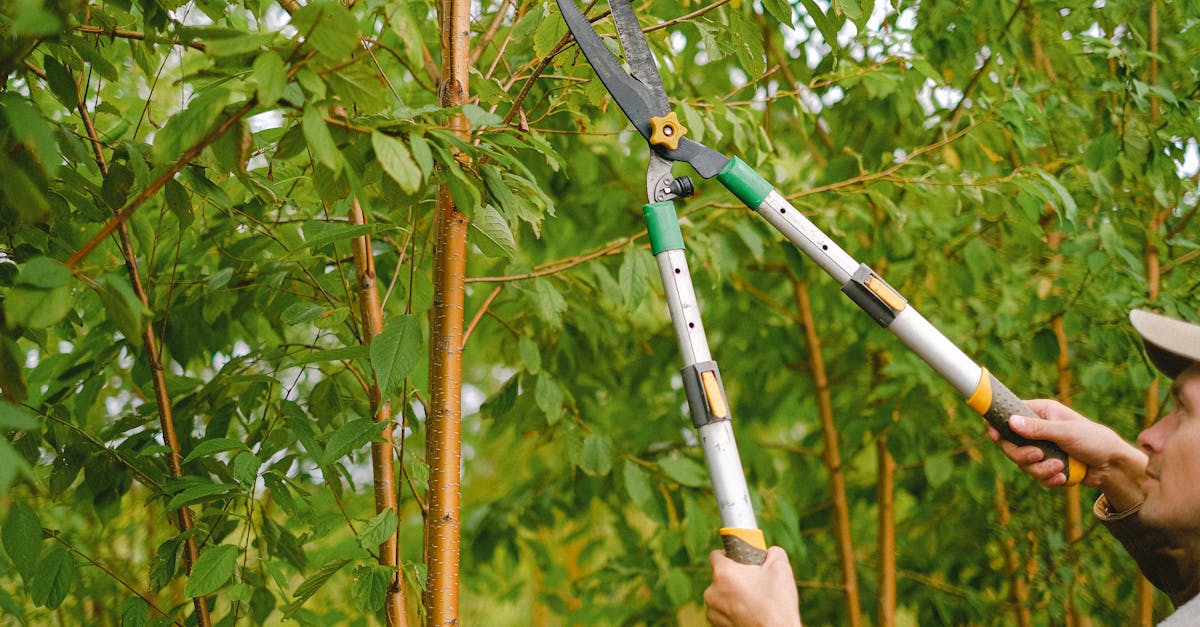
Removing Excess Foliage
When dealing with a tree that has become excessively tall, the process of removing excess foliage is crucial. By strategically trimming back overgrown branches, the tree's overall health and appearance can be significantly improved. Toronto, Springfield Tree Pruning experts recommend carefully selecting which branches to trim to maintain the tree's structural integrity while promoting healthy growth.
It is important to use proper pruning tools when removing excess foliage to ensure clean cuts that aid in the tree's healing process. Avoid leaving behind stubs or making cuts too close to the trunk, as this can lead to potential decay and insect infestations. Consulting with professionals from Toronto, Springfield Tree Pruning can provide guidance on the appropriate techniques for safely trimming an overly tall tree.
Thinning out the canopy for better light penetration
Thinning out the canopy of a tree that has grown too tall is crucial to ensure better light penetration and overall health of the tree. Trimming the excess branches allows more sunlight to reach the inner parts of the tree, promoting better growth and proper photosynthesis. It also helps reduce the weight and stress on the tree's limbs, preventing them from breaking during storms or harsh weather conditions. For professional assistance in thinning out the canopy of tall trees, consider hiring experts like Bissell, Springfield Tree Pruning, who have the skills and experience to perform the job effectively.
Properly thinning out the canopy should be done strategically, focusing on removing dead or crossing branches that hinder light penetration. By carefully pruning the tree, you ensure that the remaining branches have enough space to grow and receive adequate sunlight. Avoid over-pruning, as this can weaken the tree and make it more susceptible to disease and infestations. Entrust the task of thinning out the canopy to specialists like Bissell, Springfield Tree Pruning, to ensure that the tree is trimmed correctly and maintains its structural integrity for long-term health.
Cleaning Up the Tree
Cleaning up the tree after trimming is a crucial step to ensure a tidy and safe outdoor space. Remove any fallen branches, leaves, and debris from the ground surrounding the tree. This not only enhances the tree's appearance but also prevents pests and diseases from taking hold. For professional assistance in cleaning up after tree trimming, consider hiring experts like Ridgely, Springfield Tree Pruning, who can handle the task efficiently.
Properly disposing of the trimmed branches and debris is equally important. Depending on the size of the tree, you may need to cut the branches into smaller pieces for easier disposal. Recycling the branches as mulch or compost can be a sustainable option. Alternatively, you can contact a local waste disposal service for guidance on eco-friendly disposal methods. Entrusting this task to experienced professionals such as Ridgely, Springfield Tree Pruning can ensure that the tree trimming process is completed thoroughly and responsibly.
Properly disposing of trimmed branches and debris
After trimming a tree, it is essential to properly dispose of the trimmed branches and debris. Neglecting this step can lead to a messy and potentially hazardous backyard. To ensure a clean and safe outdoor environment, contact Ridgely, Springfield Tree Pruning for professional assistance in removing the cut branches and debris.
Improper disposal of tree trimmings can result in unwanted clutter, obstructed pathways, and potential safety hazards. Ridgely, Springfield Tree Pruning offers efficient and eco-friendly methods for disposing of trimmed branches and debris, leaving your yard tidy and free of any tree-related waste. With their expertise, you can maintain a well-groomed and hazard-free landscape, promoting the health and aesthetics of your outdoor space.
Monitoring the Tree's Growth
Regularly inspecting your tree for new growth or signs of any issues is crucial in maintaining its health and aesthetics. This step is essential to prevent the need for aggressive trimming in the future. By keeping a close eye on the tree's development, you can address any potential problems early on, ensuring the tree continues to thrive. Toronto, Springfield Tree Pruning services recommend conducting routine checks to monitor the tree's growth patterns and overall condition.
Additionally, monitoring the tree's growth allows you to assess whether the previous trimming efforts have been successful. Observing how the tree responds to pruning can help you determine the effectiveness of your techniques and make any necessary adjustments for future maintenance. By staying attentive to the tree's progress, you can promote healthy growth and maintain a balanced canopy structure. Toronto, Springfield Tree Pruning experts advise homeowners to establish a consistent monitoring schedule to ensure the tree remains in optimal condition.
Regularly inspecting for new growth or issues
Regularly inspecting your tall tree for new growth or potential issues is crucial for its health and maintenance. Keep an eye out for any signs of disease, pest infestation, or structural problems that may arise. Ensuring your tree's well-being through consistent monitoring can prevent any issues from escalating and help you address them in a timely manner. Professional arborists from Toronto, Springfield Tree Pruning recommend conducting these inspections at least once a month to catch any concerns early. By staying proactive and attentive to your tree's condition, you can promote its longevity and vitality.
Additionally, monitoring the growth of your tree allows you to assess its progress and make informed decisions about pruning and maintenance practices. Observing how your tree responds to previous trimming sessions can help you determine the effectiveness of your efforts and adjust your approach accordingly. By regularly evaluating the development of your tree, you can better understand its unique needs and provide appropriate care to support its growth. Trust the expertise of Toronto, Springfield Tree Pruning professionals to guide you in monitoring your tree effectively and maintaining its healthy condition.
FAQS
How do I know if my tree is too tall and needs trimming?
You may need to trim your tree if it is interfering with power lines, growing too close to structures, or blocking sunlight. Additionally, a visually unappealing shape or excessive canopy size could indicate the need for trimming.
Is it okay to trim a tree that is too tall myself, or should I hire a professional?
Trimming a tall tree can be dangerous and require specialized equipment. It is recommended to hire a professional arborist to safely and effectively trim a tree that is too tall.
How much should I trim from a tree that is too tall?
It is important not to remove more than 25% of a tree's foliage during a single trimming session. Over-pruning can stress the tree and lead to health issues.
When is the best time of year to trim a tree that is too tall?
The ideal time to trim a tall tree is during its dormant season, typically late fall or winter. Avoid trimming during the active growing season to minimize stress on the tree.
Will trimming a tree that is too tall harm the tree in any way?
When done correctly and in moderation, trimming a tall tree can promote healthy growth and improve its overall appearance. However, over-pruning or incorrect trimming techniques can damage the tree and compromise its health.




